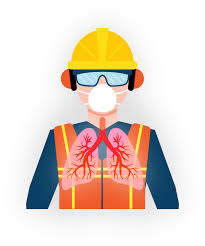This week I found an intriguing video on the hazards of silica dust from 1938!!?! See “Stop Silicosis 1938 US Department of Labour” Yes, it’s a black and white special complete with a dinky Musac soundtrack. And, if you really want to go down the YouTube rabbit hole check out the video from 11th Oct 2018 ABC News Silicosis crisis: Workers dying making kitchen benchtop.
This month WorkSafeNZ published a document that has similar messaging Guidance on Silica Dust in the Workplace.
What’s the problem with silica dust?
Silica is a natural substance that is used in all sorts of building products including concrete, bricks, rocks, and stone (especially engineered stone i.e. composite kitchen benchtops).
Respirable crystalline silica (RCS) can cause a long slow death from silicosis. Think about being completely exhausted, needing an oxygen tank to breath and eventually having your own lungs drown you. Or, you could enjoy the effects of lung cancer and/or chronic obstructive pulmonary disease (COPD) which is a fancy name for smoker’s cough.
Who does it affect?
This affects you if your team does any of the following tasks:
- quarrying
- roading
- foundries
- construction: concrete, stone, bricks, mortar, fibre
- producing cement products
- manufacturing of concrete, bricks and tiles
- kitchen benchtop manufacturing (natural and engineered stone)
- Kitchen benchtop finishing and fitting
- abrasive blasting
What can you do about it?
You really need to look at your site and do your own risk assessment and discuss possible control measures with your team. However, here are a few ideas start you off:
- Wet working: Use water spray or misting systems to suppress dust and frequently hose down the work area.
- Dust Control Methods: Physically isolate dust creating machines and have engineered extraction installed. Or, purchase hand tools that have dust control and collection features, then use H-class HEPA-filtered vacuum cleaners to keep the site tidy. NB dust waste bags must be sealed tightly and disposed of appropriately.
- Admin Stuff: Set up exclusion zones and schedule dust creating work for times when there are fewer workers on site
- Personal Protective Equipment (think masks). Work out if your team needs a half-face or full-face respirators, then teach them how to fit the masks and maintain them. The UK has an excellent online tool that helps explain all this, see RPE Selector Tool
- Environmental and Health Monitoring: If most of your work happens at one location, talk to an occupational hygienist (someone with the scientific/technical qualifications and appropriate equipment). Get them to conduct environmental monitoring. If you exceed the workplace exposure standards start your health monitoring regime.
- Training: It’s not just about training your frontline workers to make sure they know how to use the tools and wear a mask; you need to make sure your supervisors are regularly checking that the set-up is still working, and everyone is looking for ways to improve the process
More Useful Information on Silica Dust
Controlling dust with on-tool extraction Fact Sheet
Respiratory Protective Equipment – advice for PCBUs
Workplace Exposure Standards (WES)
As always, if you have anything to add to the discussion on silica dust exposure in the workplace please call Sarah on 0272 007 680 or email sarah@employmenow.co.nz.
Have a safe and productive week,
SB
